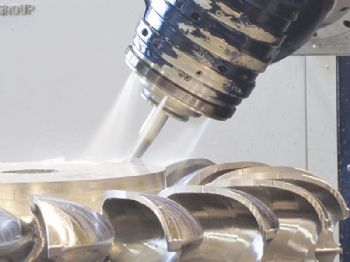
Modulo Tre — based at Schio in northern Italy — was founded in 1995 by partners Alessandro Corà, Marco Dal Bianco and Gilberto Dal Pozzo.
The company now has a number of latest-generation machines capable of handling workpieces up to 12,000 x 1,500 x 3,200mm; and by using a five-axis capability, it can machine a wide range of components in a variety of materials — including stainless steel, light alloys and super-alloys.
The decision to move to continuous five-axis working came about seven years ago and resulted in the purchase of a Soraluce FP 12000 — a floor-type multi-purpose milling and boring centre.
This machine gave Modulo Tre access to the energy industry with the production of components for the hydro-electric, oil and gas, and wind-power sectors.
The company also does work for the automotive and aerospace industries.
Undertaking five-axis working created the need for reliable and simple CAD/CAM integration, which led Modulo Tre to install the VISI (
www.visicadcam.com) portfolio of 3-D CAD modelling software and 2-D to five-axis machining software — interfaced to the Eureka kinematics simulator.
Mr Corà said: “Our primary requirement was having an integrated CAD and CAM system.
In the past, we had to leave the CAM environment to make any modifications or corrections and then reset it all, but that is very complex with five-axis machining.
"As a result, we decided to replace our previous software with VISI, which is fast and intuitive — even when implementing corrections and modifications that often have to be applied to the customer’s original CAD model for manufacturing purposes.”
He says that with VISI Modelling, small errors found in imported model surfaces can be automatically ‘healed during stitching’, “avoiding the time-consuming process of constructing very small surfaces to close tolerance gaps.
Where surfaces are corrupt or missing, VISI automatically produces edge curves that make it easy to create new surface data. To check tolerances, the old and new surface can be compared, and the maximum and minimum distances checked, along with the curvature difference.
“Furthermore, the solid closure of a surface model eliminates any design problems that may arise, making it easier to remove or add holes, fittings and other modelling features.
“The ability to move from solid to superficial model — and vice versa — also gives maximum freedom in managing CAD modifications.”
Another key requirement for Modulo Tre was to have a reliable kinematic G-code simulator that would allow programmers to virtually ‘walk through’ the machining process — hence the development of the application for interfacing VISI with Eureka; this allows the transfer of all part and CNC machine models, tool parameters and tool-path data from VISI to the simulator.
Mr Corà says: “For complex five-axis machining, it is crucial to be able to drive almost ‘with your eyes closed,’ avoiding collisions and tool issues that could compromise the entire machining of the workpiece.
“Our machines often work ‘round the clock’, so a simulator is indispensable for operations in unattended areas.”
Mr Dal Bianco says a particular feature of VISI that he appreciates is its ability to automatically recognise manufacturing features such as holes and pockets, and to generate the appropriate tool-paths.
“All holes are recognised automatically, and the correct machining cycle is applied.
“For complex machining, VISI allows us to handle high-speed and five-axis operations, as well as traditional milling; and thanks to the Compass feature-recognition module, it is also possible to associate hole recognition with custom drilling sequences such as centre, threading, boring and pocketing.
“Once the tool set has been established with the correct feed, rotation and parameters, the system automatically shows the tool that best suits the drilling type — plus the corresponding optimised tool-path.
“This automation is particularly useful when deep-hole drilling and producing intersecting holes, as with automotive moulds with complex cooling channels.
“When an intersection is detected, the system automatically reduces the cutting data, eliminating the risks of possible puncture breaks, which would be really disastrous at certain critical points.”
VISI also offers a wide range of multi-axis machining strategies that are particularly suited to the development of turbine impellers — one of Modulo Tre’s main business areas.
Typically, these are rough-milled along a ‘guide curve’, as this allows a high chip rate to be maintained, along with optimum tool contact and a constant rate of material removal.
Mr Dal Bianco says: “This results in a constant load for the spindle and all five moving axes; and while care is needed when defining the finishing strategy, the ‘rest machining’ command detects areas left by previous tools, so that they can be re-machined.”